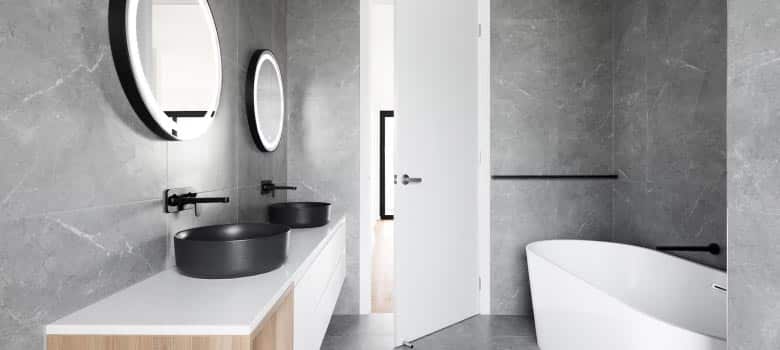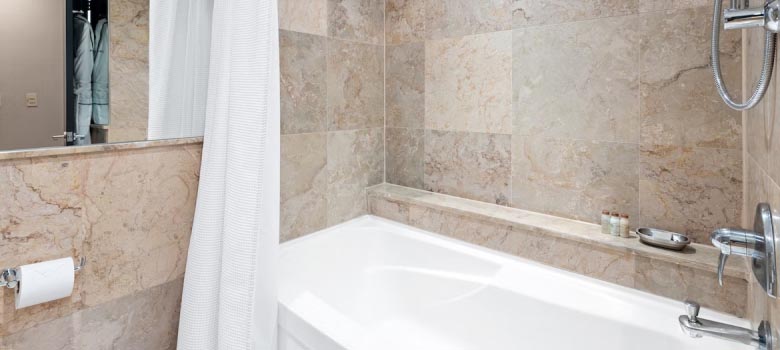Is Tiling a Bathroom Easy? The Quick Guide for DIY Tilers

We’ve all been there – you see a faded tile, a cracked counter, a dingy tub, or just a blah bathroom, and we know that it’s time for a change.
But paying for a professional to retile your bathroom or execute a total remodel can be costly and stressful, so you may be tempted to go the DIY route.
At the same time, small mistakes during a bathroom tiling job can have seriously big (a.k.a expensive) consequences.
To help keep your budget (and stress levels) down, here’s everything you need to know about tiling a bathroom, how hard it is, and when to call in the professionals.
If you want to learn more about bathroom tiling, check out our other resources:
1. How Much Does it Cost to Tile a Bathroom?
2. What Types of Tiling Are the Best for Bathrooms?
3. Top Bathroom Tiling Ideas
4. Materials for Bathroom Tiles: A Complete Guide
Tiling a bathroom: The basics
If you watch a tiling how-to video on YouTube or you see a professional completing a job, it may seem like tiling a bathroom is a quick, easy, and no-fuss job. But that’s not the reality, especially if you don’t have a professional background in a similar field.
Instead, there’s a lot that goes into tiling a bathroom. Here, we’ll delve into all the details that you have to keep in mind so you can determine if you’re up for the DIY task.
7 things to keep in mind when tiling your bathroom
To get tiling right, there are a few things that you must always keep in mind. We’ve broken these down into 7 crucial considerations so you can get tiling without worrying you’ve skipped an important step along the way.
#1 -Substrate is key
First, it’s important to remember that your tiling job will only be as good as what’s underneath it. If you don’t have a solid underlayment or substrate, your tile simply won’t lie flat. In such instances, you’ll experience issues like lippage (variances in tile height), an uneven feel, or cracks. That’s why it’s super important that you make sure to lay a great foundation.
#2 – Protect your body
Tiling a floor may seem like a super safe DIY job – after all, you’re not working with electricity, gas, or any other material that is inherently dangerous. That said, you can still get injured. For one, constantly crouching or being on your knees can strain both your knees and your low back. Additionally, you risk injury when cutting tiles. It’s important, then, that you make sure that you’re in good enough physical condition to get the job done. You should also be sure to purchase the right equipment, like tiler’s knee pads.
#3 – Use the right kind of mortar
If you do the job yourself, we recommend you go with a pre-mixed thinset mortar. Dry mortar can be hard to mix correctly, and if you have the wrong water-to-thinset measurements, it can prevent your tiles from sticking properly and affect their long-term staying power.
That said, you will have to mix dry thinset yourself if you’re working in a larger room. Otherwise, the pre-mixed product will dry out before you have a chance to get the job done.
#4 – A DIY tradesperson has the right tools
Not all tiling tools were created equal, and there is no one tool that works for all tiling jobs. If you’re spreading mortar, for example, you need a notched trowel. This will help you control how much thinset is spread on the substrate thanks to the sized notches on each side of the trowel.
If you’re spreading grout over tile, you’ll need a rubber grout float. This will let you spread the grout without scratching the tiles. And, of course, for mixing the mortar, we recommend a corded drill.
Having all of the right tools will be necessary to make sure that the job is completed effectively and professionally.
#5 – Remember to space your tiles
Your tiles should have an even amount of space in between them. This can be hard to achieve under any circumstances, but it’s made even more complicated by the fact that thinset is slippery, and it can cause tiles to slip and slide. That’s why we recommend that you use tile spacers. They’re difficult to remove, but they’ll help make sure that you have perfect spacing in between your tiles, and that it doesn’t look like a botched, uneven job at the end.
#6 – The right backing material is key
If you’re working in a high moisture area, like around a sink or a shower, you will need to use special backing material, as well as special grout sealing techniques. Otherwise, you will face mold and the possibility of water seeping through your tiles – and, if that happens, they simply won’t last.
#7 – Plan for your style BEFORE you start tiling
Looking to break up a plain grid with some diagonal wall tiles? Or need to cut floor tiles to fit a certain shape or sized space? None of this will be easy. Diagonal tiles are a nightmare for even the most seasoned professional, as they can require some pretty complex calculations. Cutting tiles, similarly, will require the right cutting tools, including a wet tile saw or a snap tile cutter.
And this final step is important to get right. Otherwise, you’ll deal with jagged looking tiles or wavy diagonal lines that look haphazard.
Need a little inspo? Here are the most popular tiling patterns in Australia
How do you know if you should hire a professional?
As you can tell, there are a lot of things that need to go right when you’re considering tiling a bathroom. You need:
- The right substrate, grout, and backing
- The right tools apply mortar, cut tiles, and apply grout
- The ability to evenly space and lay your tile
- To make sure that your tile is totally waterproof
- To make sure that your tiling is even
If you think you can easily handle all of this, great! If you have some doubts, we recommend that you hire a professional. To that end, you also need to make sure that you’re hiring the right person for the job. That’s why it’s important that you vet any potential candidate and ask:
- How long they’ve been working in your area: It’s usually better to work with an established business, as they will be able to provide a clear track record of their jobs and their success.
- If they can provide any references: Ask specifically if they can provide references for jobs similar to yours. That way, you’ll be able to talk to someone in your shoes about their customer experience and their happiness with the contractor. You can view our testimonials here.
- If they offer any insurance or warranties: You want to make sure that the job is going to last – and that the professional you’re talking to will be there if there are any issues.
- If they are licensed and insured: This is another way to make sure they can complete the job successfully
Wondering how long a tiling project takes? Get the answer here
Need help on your next bathroom project?
So is tiling a bathroom easy? The short answer is no, no kind of tiling is inherently easy, especially if you’re not well-versed in the various materials, tools, and strategies that go into getting it right. That’s why we always recommend that you at least consult with a professional before going DIY. That way, you can at least get some advice and know where to start.
If you have any more questions about tiling your bathroom, or you’d like to get a tiling quote, feel free to call us directly on 0402 462 570. You can also contact us by filling out the form here, and we’ll get back to you as quickly as possible.
